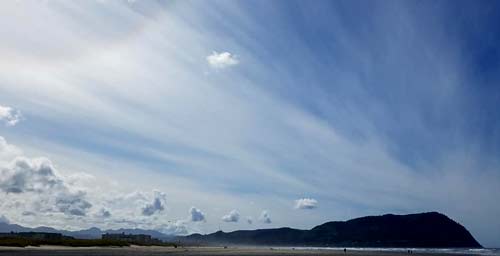Difference Between Sun Dogs and Sun Halos: Lovely Oregon Coast Science
Updated Periodically
By Oregon Coast Beach Connection Staff

Includes exclusive listings; some specials in winter
In Cannon Beach:
Includes rentals not listed anywhere else
In Manzanita, Wheeler, Rockaway Beach:
Some specials for winter
In Pacific City, Oceanside:
Some specials for winter
In Lincoln City:
Some specials for winter
In Depoe Bay, Gleneden Beach:
Some specials for winter
In Newport:
Look for some specials
In Waldport
Some specials for winter
In Yachats, Florence
Some specials for winter
(Oregon Coast) – One of the more fascinating finds and sights on the Oregon coast are sun dogs, moon dogs, sun halos or moon halos. They are not exclusively viewed on the beaches, but some can be a little less rare out here, and they add a truly heavenly aspect to your beach experience if you’re lucky enough to catch one. (Above: sun dog photo courtesy Tiffany Boothe, Seaside Aquarium).
Sun dogs are part of a larger family of halos that includes the stunning moon halos – which come in many forms. But there’s a difference between sun dogs and halos, whether it’s moon halos or sun halos. Sun dogs are rarer formations where there are two bright spots on either side of the sun (or moon, much more rarely). Like a lens flare effect on a camera. Sun or moon halos are simply giant bright circles around either the sun or moon.
Tiffany Boothe of Seaside Aquarium has acquired some photos of these in the past, seen here.
 Sundogs also go by the names sun dog, mock sun or parhelion: their scientific name is parhelia. (At right: photo Oregon Coast Beach Connection - a sun dog at Pacific City).
Sundogs also go by the names sun dog, mock sun or parhelion: their scientific name is parhelia. (At right: photo Oregon Coast Beach Connection - a sun dog at Pacific City).
“Also known as a phantom sun, sun dogs are created by ice crystals in the atmosphere interacting with light,” Boothe said.
They show up as a pair of bright spots on either side of the sun. Often, they are seen with a large, luminous area around the sun as well.
Like many light phenomena associated with the sun – including the Green Flash at sunset on the Oregon coast – refraction is the key. Scientists say sun dogs are caused by ice crystals with a hexagonal shape, sitting high in the atmosphere in very cold air. These act like prisms, bending the light and making interesting, luminous shapes. The taller the sun dog, the more these objects are wobbling as they move through the atmosphere.
They tend to be visible more often when the sun is close to the horizon, and in that lie some interesting tricks of light. The part closest to the sun can be more red, while the parts farther from the sun tend to be more blue or green.
Both halos and sun dogs are created by refraction, meaning the light is passing through the ice crystals are being bent. With halos, light is usually being bent by 22 degrees, but sometimes at 46 degrees.
Moon halos are sometimes at least as stunning, and they are the result of tiny ice crystals lurking high in the sky, usually around 20,000 feet above and existing as thin, wispy clouds. These come in two flavors: a giant, whitish ring around the moon, or a blob of colors surrounding the moon. Both require a thin layer of clouds that does essentially the same thing in terms of refraction that the sun dog does.
Many of the multicolored forms are much smaller, but they seem to have a rainbow full of colors. Amusingly, they can also resemble Pac Man in the sky.
Moon halos like this – and the whitish kinds - often mean rain or snow are coming soon, and they are often the forerunners of storm clouds right behind. More photos of these phenomena below: Oregon Coast Lodgings for this event - Where to eat - Maps - Virtual Tours
Cannon Beach Lodging
Nehalem Bay Lodgings
Manzanita Hotels, Lodging
Three Capes Lodging
Pacific City Hotels, Lodging
Lincoln City Lodging
Depoe Bay Lodging
Newport Lodging
Waldport Lodging
Yachats Lodging
Oregon Coast Vacation Rentals
Oregon Coast Lodging Specials

Above: sun halo photo courtesy Angi Wildt. Below: two incarnations of moon halos.


More About Oregon Coast hotels, lodging.....
More About Oregon Coast Restaurants, Dining.....
LATEST Related Oregon Coast Articles
Dec 21 is the solstice, bringing longer days and a sunset surprise. Weather
Sneaker Wave Alerts on Oregon / Washington Coast - Shipwreck Debris Alerts fo...
High, dangerous waves, and debris from a sunken ship coming in. Weather
Tsunami Alerts May Get Delayed, Not as Accurate for Oregon / Washington Coast
Funding cut off for some seismic stations, leaves coast more vulnerable. Weather
Winter Wreath-Making Event at Oregon Coast's Netarts Creates Homespun Vibe
Winter Wreath-Making Workshop on Sunday, December 7. Oceanside events
Bones of N. Oregon Coast Sperm Whale Getting Shuffled As Rest of It Turns Int...
Whale corpse there since June, now parts are rotting or large bones. Marine sciences, Sunset Beach, Gearhart, Seaside
Tragic Death in Lincoln City Surf Sunday During Varied Wave Alerts on Oregon ...
One person found dead in breakers as High Surf Advisory in effect. Weather
N. Oregon Coast Group Holds Sunset Walk at Netarts Bay
Along the shores and the adjacent beach on Saturday, October 18th. Oceanside events, Pacific City events
Four Unusual Oregon Coast Weather Phenomena
Ever heard of a fog tsunami, flying foam or Novaya Zemlya? Sciences. South coast
Back to Oregon Coast
Contact Advertise on BeachConnection.net
All Content, unless otherwise attributed, copyright BeachConnection.net Unauthorized use or publication is not permitted

















































